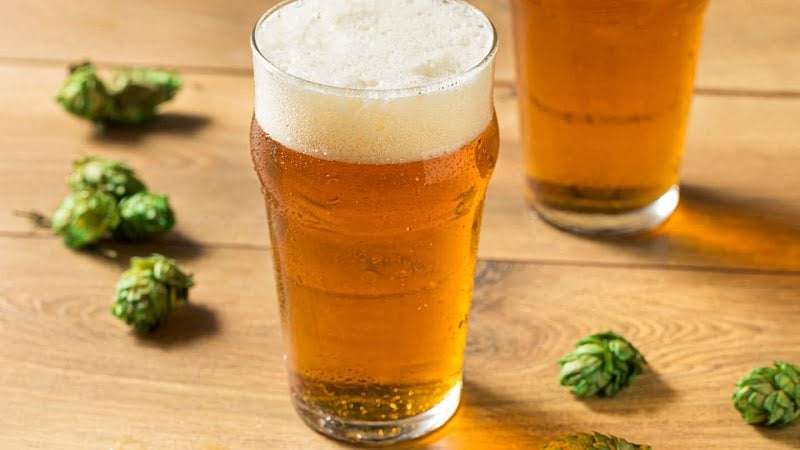Terpenes in Beer: What Are Their Effects in The Beermaking Process?

Terpenes are naturally occurring molecules commonly found in plants. You may not realize it, but these substances are also in beer, especially some more experimental craft beers. Learn how terpenes are used to impart unique flavors in beer and how brewmasters are fermenting beers in a way that produces their own natural terpene profiles.
What is a Terpene?
A terpene is an organic compound made up of carbon chains and isoprene units — 5-carbon building blocks. They’re by-products of enzymatic reactions between primary metabolites, such as sugars or amino acids.Terpenes have unique properties depending on their exact molecular structure. These secondary metabolites can have 2, 3, 4, or 6 isoprene units. This may be the first time you hear about terpenes, but it’s not the first time you’ve experienced them. For example, they’re what give lavender, lilac, and lemons their unique aroma. Terpenes have also been used as a source of medicine for millennia. Many medicinal plants owe their benefits, at least in part, to their terpene profiles. A few examples from our strain-specific terpenes include chamomile, mint, lemon balm, and of course, cannabis.
List of Terpenes in Beer
Hops (flowers of the hop vine) are used in beer because they’re terpene-dense and give beer its flavor, color, and aroma. Hops are the primary source of terpenes in beer, except for certain craft beers that add other terpenes to a unique flavor profile (more on this later).
1. Myrcene
This sedating monoterpene has spicy, musky, and fruity notes and lemongrass, basil, and mangos.This terpene has a high concentration in hops and gives beer its characteristically “hoppy” flavor. The more hops added, will increase the intensity of the hop flavor.
2. Caryophyllene
This sesquiterpene has a herbaceous scent and is in pungent herbs and spices such as clove and rosemary. It’s also the only terpene that directly interacts with the endocannabinoid system in the body.In beer, it works with myrcene to give peppery notes on the palette.
3. Humulene
Hops have the highest concentration of humulene out of any known plant. Though water-insoluble, their flavor remains present in hop-heavy beers. They have a woodsy, earthy, and spicy smell and taste.Myrcene, caryophyllene, and humulene work together to create the distinctive “hoppiness” smell and taste of beer.
4. Linalool
Linalool is in many plants like cannabis and lavender and gives fresh floral characteristics. It provides beer fresh, fruity, and flowery notes.
5. Limonene
As its name suggests, this terpene is prevalent in lemon and gives a fresh citrus flavor and scent. It gives beer, especially sours, their distinctive tart citrusy taste.
6. Geraniol
This monoterpene has a sweet floral and herbaceous scent and has insecticidal and repellent properties. It gives the beer a rose scent and enhances the citrus and floral notes of other terpenes.
7. Alpha-Terpineol
This has a fresh citrus note with a subtle pine scent. In beer, it doesn’t add aroma, but it enhances the other fragrances of the hops.
8. Alpha-Pinene
Common in pine trees and rosemary, this adds a musky, woody, and piney aroma. It gives certain beers their woody and herbaceous smell, commonly seen in IPAs.
9. Eucalyptol
This gives off a minty and fresh scent and may improve concentration. This gives the beer a cooling effect and adds to the beer’s refreshing taste.
How do Terpenes Affect Beer?
 Terpenes affect the final flavor, color, and taste of beer.Malted barley and hops give beer its signature flavor profile. Hops contain many terpenes, but the temperature and timing need to be controlled to extract as many as possible.Beer flavor changes based on the amount of time the barley is toasted, but brewers also add a secondary infusion of hops to permeate the beer with specific flavors.
Terpenes affect the final flavor, color, and taste of beer.Malted barley and hops give beer its signature flavor profile. Hops contain many terpenes, but the temperature and timing need to be controlled to extract as many as possible.Beer flavor changes based on the amount of time the barley is toasted, but brewers also add a secondary infusion of hops to permeate the beer with specific flavors.
Can Terpenes be Added to Beer?
Yes, terpenes are usually added to beer. High temperatures in the boiling process can destroy the natural terpenes in hops. Brewmasters add a secondary dry-hop stage or use concentrated terpenes to keep these flavors.The most commonly added are the water-insoluble hydrocarbon terpenes — myrcene, beta-caryophyllene, and humulene. However, brewmasters often add other terpenes to achieve a distinct flavor profile or create new flavor combinations.
What are the Benefits of Adding Terpenes to Beer?
Adding terpenes is a growing trend in craft breweries. It allows the brewer more control over the flavor profile of the finished product and helps maintain consistency between different batches. Terpenes let brewmasters experiment with different flavor combinations; there’s more competition as breweries introduce new products.Previously, the only way to change the flavor was to introduce botanicals during the process, releasing terpenes that affect the taste of the beer. However, this process is not as consistent or controlled.
When are Terpenes Added to the Brewing Process?
Brewers add terpenes after the boiling and hopping stage. They’ll do this once the liquid is cool and after the yeast is added, but carbon dioxide helps incorporate the terpenes throughout the beer before fermentation.Terpenes are dissolved in food-grade ethanol or another solvent to release their full potency. It’s possible to add them to the bitter wort before the yeast, but this risks the yeast oxidizing and bio-transforming the terpenes into undesirable ones.
How Does the Beermaking Process Affect The Terpene Content?
Beer is a fermented adult beverage enjoyed around the world. The ingredients, flavors, and fermentation times vary, but the general process remains the same for all types of beer.
1. Malting
Barley, a malt-producing grain, is soaked in water until it germinates. The sprouted grain is then drained and toasted in a kiln, like those used in pottery. This process stops germination and develops the malt flavors present in the final product.The length of this toasting process determines the color of the beer and imparts different flavors, like grassy, herbaceous notes or toasted chocolate notes.Terpenes are released when plants reach a certain temperature. The toasting brings out the terpenes from the barley.
2. Mashing
The malted grains are mashed and cracked, then soaked in purified hot water to form a porridge-like consistency.Barley enzymes work to break down the starches into sugars. The mash is constantly mixed and kept at a specific temperature to break the malt into simpler amino acids. This primary metabolite reaction releases terpenes as a by-product.
3. Lautering & Sparging
The liquid (called wort) is drained from the mash and recirculated over the solids. This pulls as much of the terpenes out of the grain mash and into the wort. The wort is then lautered or strained again and added to a brew kettle. Next comes sparging. Boiling water is poured over the remaining mash to extract as much of the sweet wort as possible, then added to the brew kettle.
4. Boiling & Hopping
Hops are mixed into the liquid after it’s brought to a boil and clarified. They’re exceptionally high in humulene, which gives an intense aroma and balances out the sweetness of the wort.Additional hops are added at the end of this process to impart even more flavor. The secondary hopping extracts more terpenes to increase the intensity of the hop flavor in the beer.
5. Cooling
Next, the mixture is strained to remove any remaining solids, then moved to the hot wort tank where it’s cooled. The yeast is added and begins the fermentation process.
6. Fermentation
This stage creates the beer. Brewers add specific yeast cultures, depending on the style of beer they’re producing and what flavors they want to develop.The yeast feeds off the sugars in the wort and converts them to carbon dioxide (CO2) and alcohol. This process can take several days up to a few months.Terpenes are further released as products of the enzymatic reaction of the sugar. The breakdown of sugar creates terpenes as a by-product. This is how the yeast can help impart flavor into the beer.
7. Cellaring
The yeast is filtered out after it dies but before the beer goes into storage. Most beer is stored in tanks for about three weeks to let the flavors and textures come together.
8. Packaging
Finally, the beer is packed into bottles, cans, or kegs and ready to be sold.
How Many Types of Terpenes Are There?
 Terpenes are broken down based upon their carbon chain structure and the number of isoprene units (C5H8).Their chemical structure can be linear or cyclic (forming a ring or series of rings).
Terpenes are broken down based upon their carbon chain structure and the number of isoprene units (C5H8).Their chemical structure can be linear or cyclic (forming a ring or series of rings).
1. Monoterpenes
Monoterpenes are found primarily in plants’ essential or suspended oils and consist of 2 isoprene units with at least one double bond.These compounds give off an intense scent and flavor. Some also give a plant its color. Companies use monoterpenes to create oil-based fragrances and cosmetics or natural flavorings for spirits, beverages, and food.
2. Sesquiterpenes
These metabolites consist of 3 isoprene units with 15 carbon atoms. While monoterpenes are generally linear in structure, sesquiterpenes can also be cyclic, bicyclic, or tricyclic.
3. Diterpenes
Diterpenes have 20 carbon atoms in 4 isoprene units. They can be linear but commonly occur in cyclic carbon chain formations (like sesquiterpenes).
4. Sesterpenes
These are found in plants, fungus, and insects, but they’re not as common as other forms of terpenes. Sesterpenes have a more complex structure consisting of 5 isoprene units.
In Summary: How are Terpenes Involved in Beer?
Terpenes are molecules that give plants their distinctive smell and taste. We experience terpenes everywhere.They’re also naturally present in beer. Brewers extract these terpenes from the hops and other botanicals to achieve specific flavor profiles. However, these processes can destroy the naturally occurring terpenes. Concentrated terpenes help achieve consistent results and particular flavor profiles.This is a growing trend amongst craft breweries, always looking to create new and unique products.